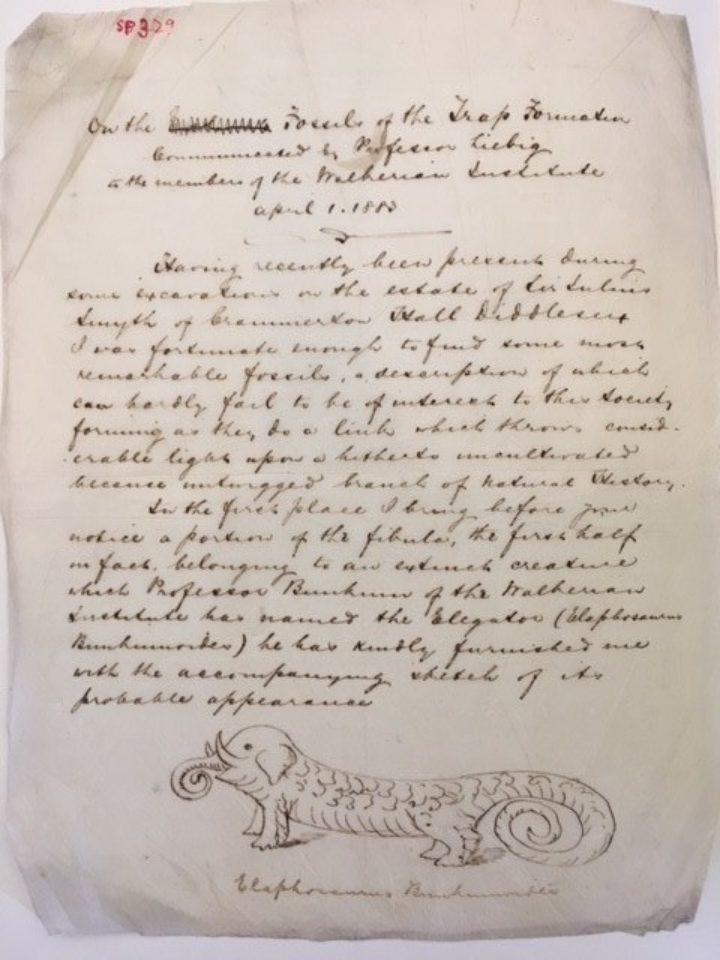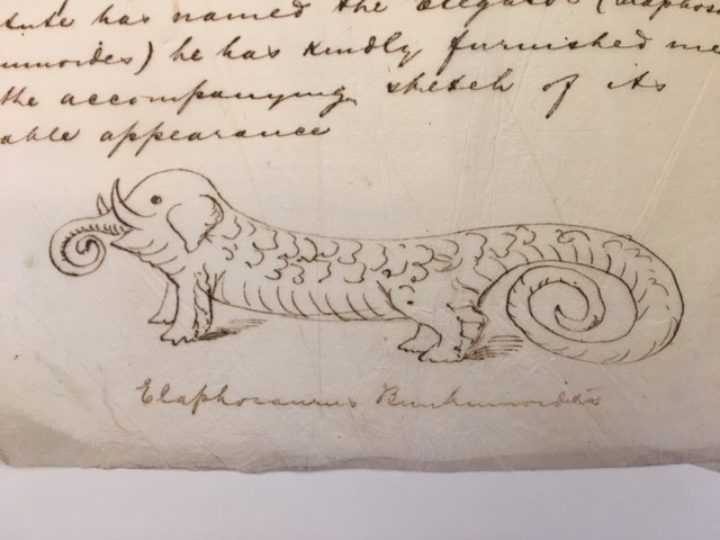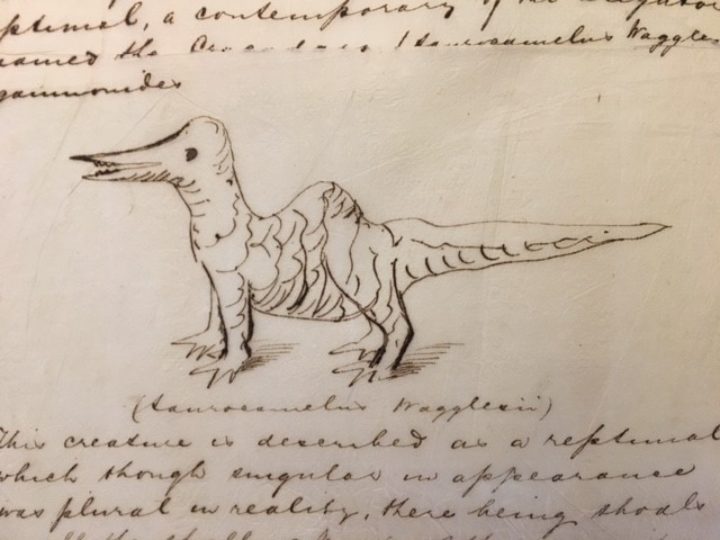Professor Liebig and the mysterious fossils of the Trap Formation
Assistant Archivist Luke Thorne examines this totally legit paper about a series of mysterious fossils that were unearthed on the grounds of an estate.
Published on 1st April 2022
As far as our collections of Society Papers go, this has to be one of the most delicate pieces in the collection. Written on extremely thin tissue paper is an account about some extraordinary fossils that were found at Grammerton Hall and were presented by Professor Liebig to members of the Walkerian Institute (SP/329).

The writer of this paper, C.T. Druery, notes that the descriptions of these finds “can hardly fail to be of interest to this Society” due to the fact that the fossils belonged to animals that have been completely neglected by natural history, and in highlighting this piece for Treasure of the Month I am also hoping to bring wider attention to this paper.
The first of these fossils was a portion of fibula belonging to an extinct creature known as the Elegator (Elaphosaurus Bunkumoides). The creature was named by a Professor Bunkum of the Walkerian Institute who described it as having “a small chest and large trunk both destitute of locks”, though it is believed that the male of the species “was sometimes hirsute”. However, what is most interesting about this forgotten mammal (or is it a reptile?) is that it was said to hibernate during the summer months! The accompanying sketch on the page depicts the Elegator with a long scaly body and tail, and possessing tusks strikingly reminiscent of an elephant.

The next fossil was no less astonishing; a collection of scales belonging to a contemporary of the Elegator, the Crocodars (Lauraeamelus Wagglesii). This creature is described as a species of “reptimal” that lived in “shoals in all the shallow parts of the rivers it frequented” and “in a state of nature ran on four legs but when properly reared as it often was by the paleojectars (stone throwing men) of its time, it went on only two”. Sadly, however, this creature could not breed when kept in captivity as “confinement killed it”, which perhaps contributed to its extinction.

The third fossil that was unearthed belonged to a creature that is said to be the missing link “between the fish & the fowl families”: the Cockerel Salmon (Salmogallus Barndous). Standing on two webbed feet and possessing a crest and tail feathers, as seen in the image below, this magnificent creature must have been a sight to behold. Portions of its vertebrae were found at the estate and the creature was said have been alive during the time of Izaak Walton (c1593 - 1683), who wrote about the fish-fowl in his The Complete Angler, writing that “large quantityes of fysche can now be gotte in ye olde Bourne near ye viaduct” and the best kind of bait to use was “gentles” (larvae).

Still reading? Well, you’ve probably caught on by now that this is an April Fool (Ha, got you!). But joking aside I thought that making a blog on hoaxes would be a fitting topic for this edition of Treasure of the Month and this excellent paper from our collection of scientific papers doesn’t disappoint with its depictions of unusual creatures and suspicious sounding professors (‘Liebig’ and ‘Bunkum’ are pretty big indicators of this paper’s illegitimacy!).
Druery’s paper however, is not the only hoax related item in the archives and during my cataloguing work I’ve come across other writings that deal with hoaxes which I also wanted to share. For instance, in E.M. Holmes’ correspondence collection there is a letter from a Rev Richard Murray (MS/235/12), dated 23 November 1892, who recounts to Holmes the origin of the ‘Shapwick Monster’, an amusing story about a village terrorised by a monster, which turned out to be a crab:
‘Long ago (Elizabeth’s time?) a fishmonger going from Poole to Blandford lost a crab from his cart while crossing Badbury Down in this parish. The crab was found by a native, who ran away in terror: - brought others to look, who also fled! Finally one Shepherd Rowe, aged & bedridden, but very wise, was brought in a wheel-barrow to see the creature. He gazed: then said, “It be an earth-monster: wheel me back again.”’
It is also said that the villages banded together, armed with pitchforks and sticks, to drive the poor creature off, which highly amused the fishmonger who had returned to retrieve his lost crab. Word spread of the ignorance of the villagers, who must have felt very foolish, and the story was commemorated in a poem by Buscall Fox (1818-1887), which can be read here.
Another mention of a hoax in the Linnean Society’s records comes from a letter between Rev. Samuel Goodenough (1743-1827) and Sir James Edward Smith (1759-1828), in which Goodenough reported the reading of a hoax paper at a meeting of the Society (GB-110/JES/COR/12/82):
‘As soon as I came into the room, I found them all talking of the absurd paper which had been read at the meeting the week before. The paper was evidently, a hoax. Before the meeting, Mr. Taylor kept talking what a funny paper he had to read & when the meeting opened, he began the paper about 2 Robins fighting & one hanging itself in a leaf of a carrot, laughing all the while most immoderately … Now really, the reading secretary should have some sense about the propriety of reading papers. He surely should consult someone, if he has not some sense of his own’.
While the paper may have amused many of the members present at the meeting, Goodenough was concerned that “this Cock Robin story” would make for bad publicity for the Society and persuaded members to not openly acknowledge it.
Though it may seem that Goodenough lacked a sense of humour, his disdain is perhaps due to the then Secretary, Alexander Macleay’s reaction to the paper. Macleay, who “had long thought of resigning his post”, became “quite determined” to resign after hearing the paper read and upon learning this Goodenough lamented not stopping the reading of the paper in the first place.

I can only hope that any jokes today don’t result in an early retirement and if you do come across something outlandish then remember to consider if the date is significant!
By Luke Thorne, Assistant Archivist
Unless otherwise indicated, all images © the Linnean Society of London, 2022
Sources
'On the fossils of the Trap Formation' [April Fool's Day prank] - C.T. Druery, 1 April 1883, Linnean Society Archive Catalogue, http://www2.calmview.co.uk/Linnean/Record.aspx?src=CalmView.Catalog&id=SP%2f329&pos=1, accessed 03/03/2022
MURRAY, RICHARD PAGET (Rev.), Blandford, 23 November 1892 (MS/235/12), Linnean Society Archive Catalogue, http://www2.calmview.co.uk/Linnean/Record.aspx?src=CalmView.Catalog&id=MS%2f235%2f12, accessed 03/03/2022
Samuel Goodenough, Berners Street, London, to Sir James Edward Smith, Norwich, [Norfolk], 18 March 1823 (GB-110/JES/COR/12/82), Linnean Society Archive Catalogue, http://www2.calmview.co.uk/Linnean/Record.aspx?src=CalmView.Catalog&id=GB-110%2fJES%2fCOR%2f12%2f82, accessed 03/03/2022
https://www.williambarnessociety.org.uk/the-shapwick-monster/, accessed 03/03/2022
